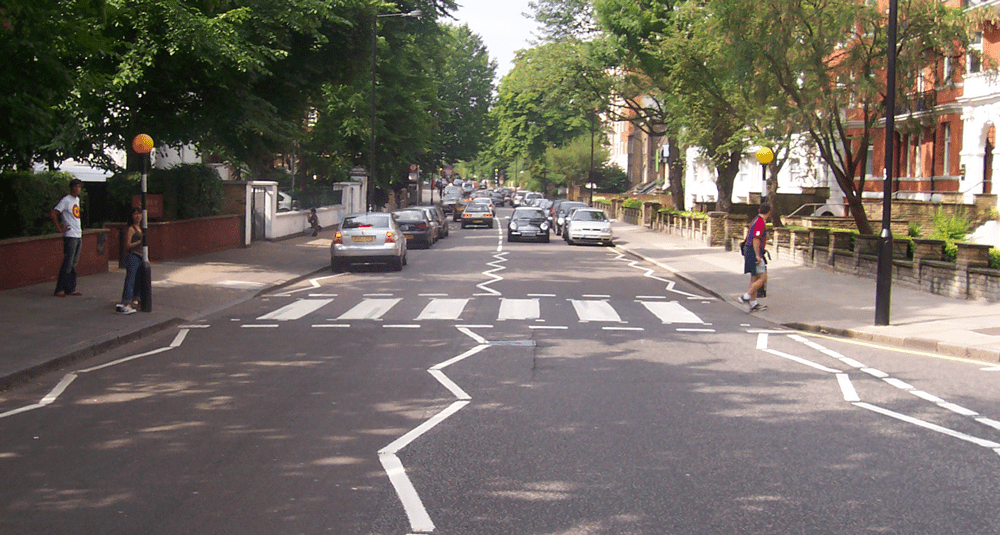Which street in London was made famous by the Beatles?
Last Updated:
Abbey Road, a street in the London borough of St John’s Wood, is world-famous thanks to The Beatles and their eponymous album Abbey Road, released in 1969. This album remains one of the band’s most emblematic, not only for its songs, but also for its cover, which shows the four members of the band crossing a crosswalk. This passage, located right next to Abbey Road Studios, has become a veritable place of pilgrimage for the band’s fans the world over.
In 1969, the Beatles were already living music legends. They revolutionized rock with albums such as Sgt. Pepper’s Lonely Hearts Club Band and The White Album. Internally, however, the band was going through a difficult period. Tensions between the members, particularly between Paul McCartney and John Lennon, became increasingly apparent. Despite this, the Beatles decided to record one last album together. This album, Abbey Road, takes its name from the recording studios where most of it was produced.
Abbey Road Studios, originally known as EMI Recording Studios, has been a favorite recording venue for many artists, but is most associated with the Beatles. It was here that the band recorded most of their songs. So the band decided to name their latest album Abbey Road in homage to the place that contributed so much to their success.
The image on the album cover has left its mark on the collective imagination. It shows John Lennon, Ringo Starr, Paul McCartney and George Harrison crossing the Abbey Road crosswalk. The photo, taken by photographer Iain Macmillan, has become emblematic. It was taken on August 8, 1969, and lasted around 10 minutes. The Beatles simply lined up and crossed the street, while Macmillan, mounted on a ladder in the middle of the road, immortalized the scene.
This cover has given rise to many interpretations and theories. One of the most famous is that of Paul McCartney’s alleged death. According to this theory, the arrangement of the members on the photo evokes a funeral procession, with John Lennon dressed in white, representing a priest, Ringo Starr in black for the role of embalmer, and George Harrison, in jeans, symbolizing the gravedigger. Paul McCartney, meanwhile, is barefoot, a peculiarity that has fueled urban legend about his death. Of course, these rumors were repeatedly denied, but they contributed to the fascination surrounding the album and the photo.
The Abbey Road album has become one of the Beatles’ greatest hits. Among the most famous tracks are Come Together, Something and the famous B-side medley, which brings the band’s career to a magnificent close. Abbey Road marked a turning point for the band and for the history of pop-rock music. Although not technically their last album (Let It Be was released later, but recorded earlier), Abbey Road is often considered the Beatles’ true artistic farewell.
Today, the Abbey Road pedestrian walkway attracts thousands of tourists every year. Fans come from all over the world to recreate the famous photo, crossing the street in the same posture as the Beatles. The site has become a place of pilgrimage, along with other iconic rock sites. Abbey Road Studios, meanwhile, continues to operate and host internationally renowned artists.
Abbey Road became world-famous thanks to The Beatles. Their eponymous album, with its famous cover, marked the history of music and popular culture. Today, this crosswalk is an essential symbol of the Beatles’ legacy. Whether for its songs or its visual impact, Abbey Road remains a timeless masterpiece that continues to captivate generations.
You may also be interested in
- On which album of the American folk rock duo Simon and Garfunkel does the song The Sound of Silence appear?
- On which album of the American rock band The White Stripes does the song Seven Nation Army appear?
- On which album of the band The Mamas and the Papas does the single ‘California Dreamin’ appear?
music

Which street in London was made famous by the Beatles?
Answer
London's Abbey Road is famous for the iconic cover of the Beatles' 1969 album, on which the band crosses a crosswalk.